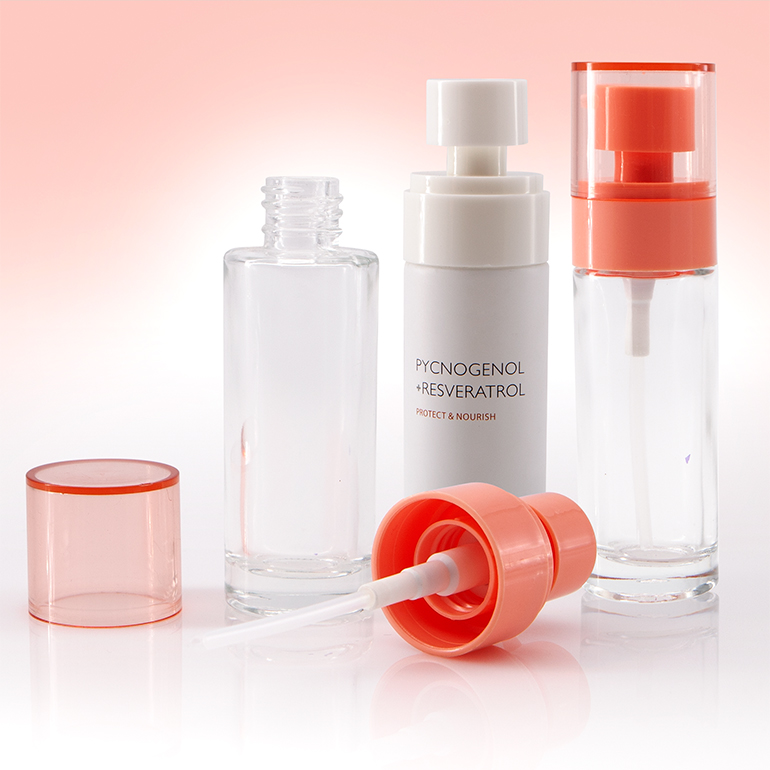The makeup of a fine mist spray bottle involves a number of different parts. The designs and the name of the parts may vary widely from one manufacturer to another. Still, the principles that all of them use are basically the same.

- Dust Cap
- Actuator
- Insert
- Closure
- Gasket
- Pump Mechanism
- Dip Tube
- Dust Cap
The Dust Cap is the topmost part of the bottle. It is a safety cap that guards the actuator and the spray hole from dust and other harmful materials. It also keeps you from accidentally pressing the actuator.
The dust cap comes in different materials and finishes. Some people may consider it an adjunct and is prone to being lost. Still, its purpose is obviously quite important too.
We recommend that you refrain from reusing spray bottles that have no dust caps. If possible, look for a replacement cap.
- Actuator or Trigger
Covered by the Dust Cap, the actuator is the part you press to dispense the bottle’s contents. It sticks out of the container like a head.
You might be familiar with lotion dispensers with actuators that are table-shaped, having a thin neck and a flat top. However, the actuator in a fine mist spray bottle is hollowed to hold other components inside of it. In a fine mist spray bottle, the actual spray hole can be found on the face of the actuator too.
- Insert or Nozzle
The Insert is practically the mouth of a fine mist spray bottle. More than that, however, it is actually the part that defines the spray bottle. This tiny piece is what turns the liquid contents into mist. Its interior consists of multiple channels where the liquid passes through before leaving the container.
The Insert is fitted inside the actuator and only appears as a small hole on its surface.
- Closure
The closure wraps the spray bottle like a collar right below the actuator. The closure fastens all components together onto the actual bottle. The Dust Cap also rests on top of the closure where it snaps securely in place.
The closure could be smooth, matte or satin. Sometimes it is even designed to appear seamlessly connected to the bottle.
- Gasket
Even though it is one of the least obvious parts, the gasket is actually a vital piece to the assembly of the spray bottle. The gasket is a thin flat material that serves as a seal to prevent the contents from leaking. It is located at the bottom of the closure in the area where it meets the actual bottle.
The materials used as gasket may vary depending on the substances that it is meant to leak-proof. It goes through tests to ensure its compatibility and reliability.
- Pump Mechanism
The heart of every fine mist spray bottle is the Pump Mechanism. Unlike the other parts, the pump mechanism is composed of several smaller parts including a piston, a housing cap, a stem, a spring, a seal, and a mother housing.
How the pump works was explained in the earlier part of this article. It is what transfers the liquid contents from the container to the actuator. The alternating actions of pushing down the actuator and letting it spring back up is what powers the pump. Releasing the actuator is what allows the pump to draw the liquid contents from the bottle and fill up its chamber. Consequently, pushing down the actuator is what drives the liquid from the chamber to the Insert and out of the bottle.
Do you notice that when a spray bottle is fresh from the store, it does not expel its contents during the first couple of pressing? That is because of how the pump mechanism works. When a spray bottle is still unused, the pump chamber is still empty. It needs the springing up motion of the actuator to allow it to fill its chamber first. Naturally, the contents will only come out at the second or third press once the chamber has already filled up.
- Dip Tube
To allow the liquid contents to travel from the bottom of the bottle into the pump, they pass through a thin passage called the Dip Tube.
The Dip Tube is connected to the bottom of the pump and extends to the very bottom of the container. Its bottom is usually cut into a “V” shape or at a diagonal angle to prevent the tube from clogging.
- The Bottle / Body
The actual bottle or the body is the largest part of the entire spray bottle. It basically holds the liquid contents and it is also what keeps the container standing upright.
Though the majority of the dispensing parts are made of plastic (except for the spring), the body may be made from a number of materials such as plastic, metal and glass.
In terms of advantages for reusing, we recommend that you choose spray bottles made of glass. Glass has unique adsorbent properties that allow it to hold liquids more effectively than other materials. Learn more about the benefits of glass bottles here.







